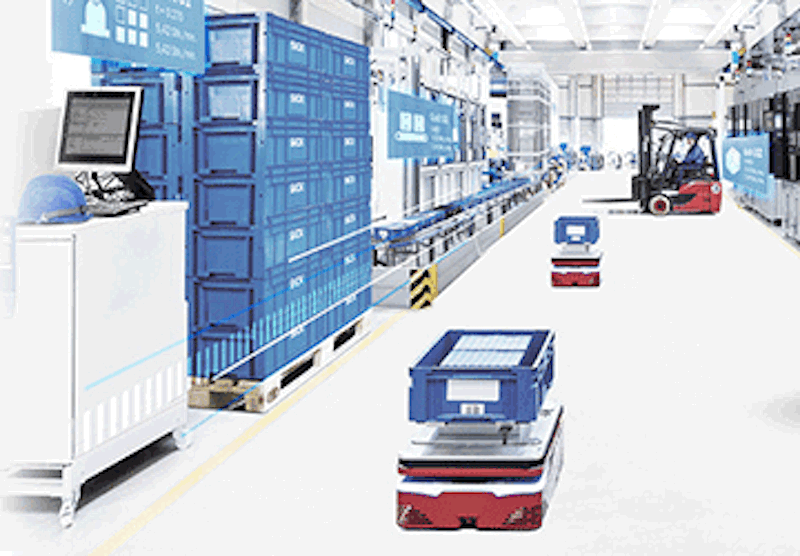
SICK presents intelligent sensor solutions for the ‘factory of the future’
At PackExpo this year, SICK is presenting numerous demonstrations and one educational session that highlight how intelligent sensors can help you create the factory of the future that includes robotics, quality inspection, and digital transformation.
Intelligent sensor solutions from SICK enhance mobile and stationary robotic applications. In its booth (C-2160) at PackExpo 2021, demos about sensor solutions for robotics and quality inspection are available throughout the show.
From 3D vision robot guidance systems for more efficient bin picking to safety and LiDAR solutions for AMRs, SICK prioritizes improving the supply chain with solutions for mobile robot safety, LiDAR localization, and robot vision systems.
Sensor solutions for robotics
LiDAR Localization Solutions for Automated Industrial Vehicles
Vehicle tracking and localization software within a manufacturing setting is essential to collaborate safely with robotic vehicles. One challenge associated with the tracking of these autonomous vehicles is a loss of tracking guidance that leads to the potential for unplanned vehicle stops and fleet jams.
Using the LiDAR-LOC software from SICK, automated guided vehicles, carts, and robots can continue to remain on track even if the magnetic or optical-guide tape happens to be missing. The system uses the 2D measurement data of the surroundings acquired by SICK safety laser scanners, which are often already present onboard the vehicle as electro-sensitive protective devices.
The 2D LiDAR localization system helps avoid vehicle standstills or fleet jams during operation because of defective magnetic or optical track guidance tapes. This translates to higher availability and leads to increased throughputs and productivity.
3D robotic bin picking solutions
Manual part picking is an expensive, labor-intensive process. As a result, repetitive manual handling is increasingly being replaced by robots. The challenge with robots, however, is that they are blind, and many are not flexible enough to accommodate ever-changing automated production processes.
With robot vision guidance systems from SICK, flexible material handling is made possible for industrial production. These customizable vision systems provide the competitive advantage many manufacturers are looking for in part localization applications.
“With the creation of many new technologies for the industrial automation industry, this is a very exciting time,” said Nick Longworth, SICK senior robotics engineer. “Simple and repetitive tasks of lifting heavy parts from deep bins, conveyors, and racks has always been a primary source of long-term back injuries, accidents, and inefficiencies.”
SICK’s PLB is a vision system that can be used for high precision localization of parts that are randomly oriented in bins and boxes. The vision system consists of a 3D camera, part localization software, and tools for easy integration.
In addition, the 3D Belt Pick system specializes in belt picking applications from conveyors. A TriSpectorP1000 3D vision sensor mounted over the conveyor belt measures products in 3D.
This enables the handling robot to grip and sort products quickly and precisely. The TriSpectorP1000 supplies the data important for quality determination, such as product position, volume, and features.
Collaborative robot safety
With the sBot safety system from SICK, it’s simple to implement effective collaborative robot safety. This safety solution enables manufacturers to safeguard accessible collaborative robotic applications.
These are easy-to-use safety systems that uses the intelligent nanoScan3 safety laser scanner. These solutions work well in handling operations using robot applications with free access and enable manufacturers to achieve safety without sacrificing productivity.
The nanoScan3 is the world’s smallest profile safety laser scanner. Its space-saving design works perfectly in mobile robotics applications, but also in stationary applications where space is limited.
It delivers high-precision measurement data and is extremely resistant to light, dust, or dirt. It also has the highest level of flexibility with up to 128 freely configurable fields and monitoring cases.
Smart data solutions for digital transformation
With connected solutions and cloud ready services, manufacturers can now be more competitive than ever before. To accomplish this, connected sensing solutions are required.
Today, intelligent sensors are not only collecting data, but are also preparing and processing it further to provide value-added information. Sensors no longer just “sense”, but now, with the beginnings of digitalization, they are also beginning to “think”.
The success of networked value creation chains is heavily dependent on the successful integration of sensors in the overall architecture of an application.
SICK recognizes that the time has come to add a new dimension to the world of sensors. With Smart Data Solutions, manufacturers receive support on the journey to implementing smart logistics processes. This includes installed base services, asset manager, condition monitoring, and predictive services.
With these services, data analysis can be run to make intelligent decisions based on the data to optimize processes. This helps to increase throughput, availability, and productivity. Check out its Innovation Stage presentation on this topic on Tuesday, September 28 at 3pm.
Reducing errors on packaging lines
With the increasing complexity of packaging types and the rising frequency of artwork changes and promotional offers, it has become more important for manufacturers to reduce, if not eliminate, any errors in the coding and packaging of products.
This is particularly important where mistakes can result in a risk to consumer health. By implementing a combined package of SICK’s extensive sensor product portfolio and AutoCoding’s software solution, manufacturers can ensure the integrity of their products.
SICK products and ACS’ coding and packaging verification solutions can be used in a range of applications. SICK’s Lector image-based code readers are used for 1D and 2D barcode scanning to check retail barcodes, backweb label barcodes, and packaging artwork barcodes.
ACS also has several vision installations that incorporate SICK’s ICR inspectors and IVC-3D cameras and are currently integrating with the new Inspector P series of cameras.


